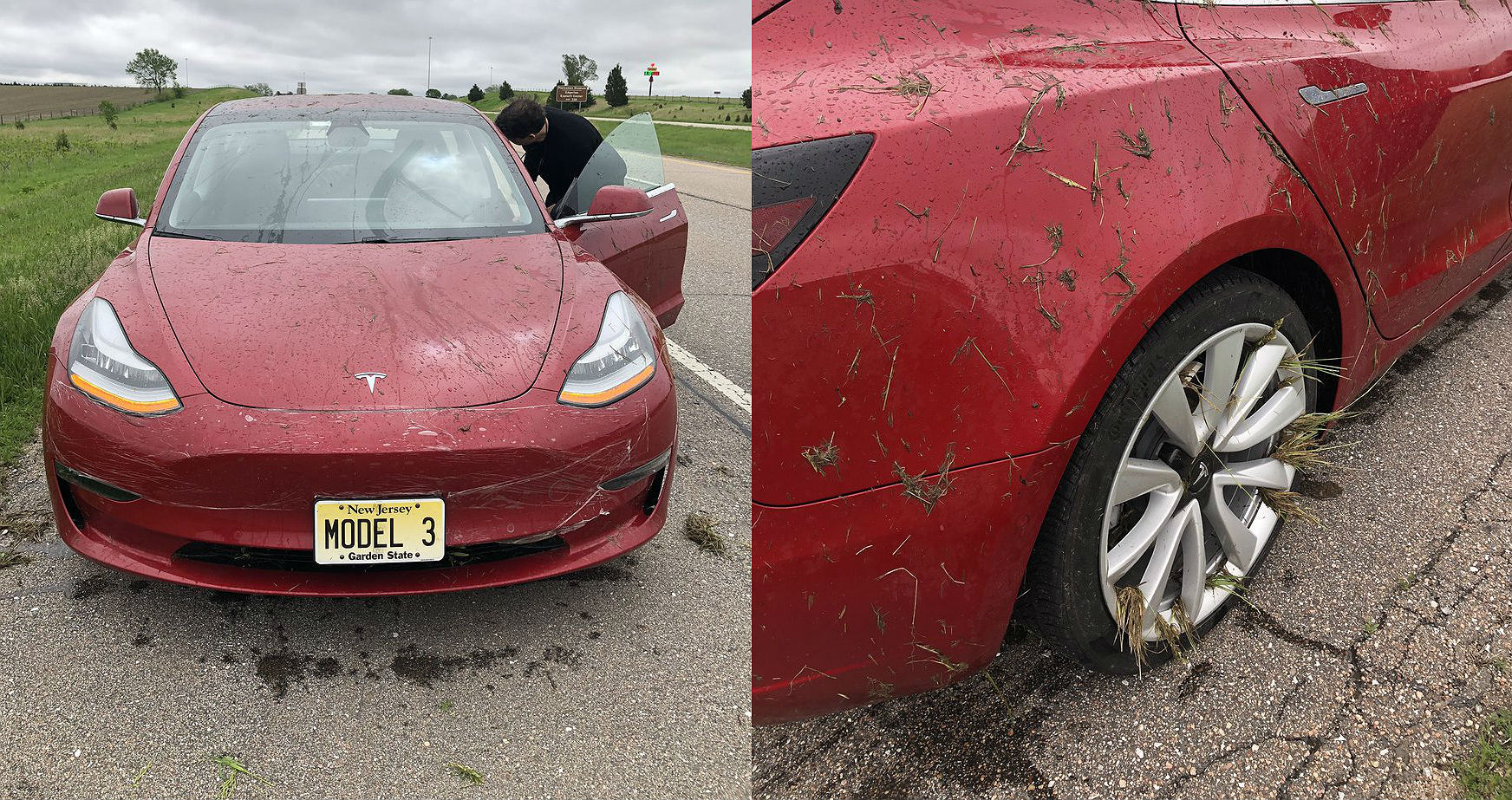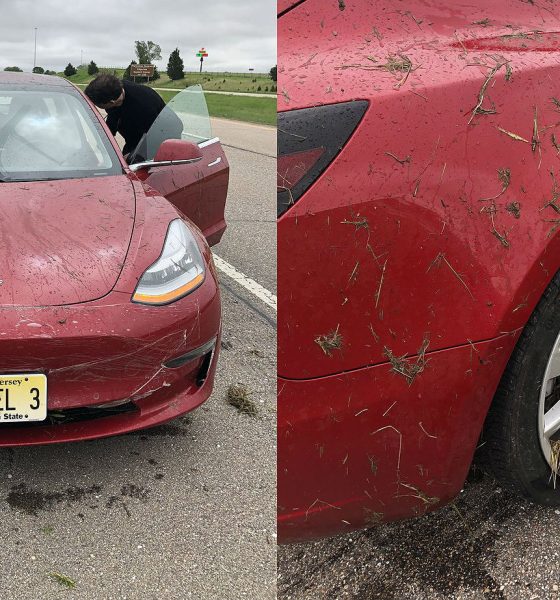

News
Tesla Model 3 protects owner by shaking off near-crash with swerving semi
A Tesla owner is thanking her Model 3’s safety features and stability after a near-miss with a swerving semitrailer in Nebraska. The harrowing incident resulted in the Model 3 fishtailing at high speed and driving into a median, then finding its traction and getting back on the road — grass, mud, bugs and all.
Vivianna Van Deerlin was driving her Long Range RWD Model 3 about 70 miles from Lincoln NE on I-80 when she encountered an unsettling sight on the road. Ahead of her, a massive semitrailer was swerving from side to side. She tried to overtake the semi carefully, but just as she was midway through the maneuver, the large truck swerved into her lane. The Model 3 was on Autopilot then, and she opted to take control of the vehicle to avoid the truck.
This caused her to fishtail and skid into the median. The incident happened while the Model 3 was traveling at 80 mph, but despite this speed, the vehicle refused to spin or roll over. Covered in grass from top to bottom, the car was able to get back on the road without any problems. None of the Model 3’s passengers were harmed, and the sedan proved tough enough to drive all the way to a service center where it could be checked for any needed repairs.
Looking at pictures of the aftermath and footage of the incident, it was evident that the Model 3 owner escaped what could very well have been a serious accident. Unfortunately, the video also revealed that the driver of the semitrailer, which caused the incident, didn’t stop to check up on the Model 3 or its passengers. It just drove on, seemingly oblivious of what transpired behind it.
The Tesla owner credits several aspects of her Model 3 for saving her and her husband’s life during the close call with the semi. She noted that her vehicle showed remarkable stability as she drove into the median thanks to its low center of gravity, and it promptly gained traction as soon as she floored it to avoid getting stuck on the muddy grass. Particularly notable was that the vehicle was an RWD version, which only had one electric motor.
In hindsight, Vivian noted that she might not have driven into the median had she not disengaged Autopilot. Past videos of Autopilot avoiding accidents, after all, show that the driver-assist system might have avoided the swerving semi without leaving the road. “Probably would’ve been better off letting AP continue but hard to know that in the moment. My reflexes just took over when the truck crossed over the white line, unfortunately there just wasn’t any shoulder to move into,” she wrote in an update on Twitter.
Fortunately, the vehicle incurred no damages from its grassy encounter. There was a ton of grass to be cleaned out and some remarkable dashcam footage to save, but apart from these, the Model 3 was completely fine.
Vivianna Van Deerlin is an active member of the Tesla community, organizing the Tesla Boot Camp program for new electric car owners. She and her husband Peter are also longtime Tesla owners, being one of the customers who placed a reservation for the Model S back in 2009 and taking delivery of the sedan in 2012. Apart from her Long Range RWD Model 3, she and her husband also own a Model 3 Performance and a rather rare 2010 Tesla Roadster Sport. In this particular trip, the Van Deerlins were taking a 3,000-mile journey from New Jersey to California to give their Long Range RWD Model 3 to their son. Thanks to the durability of the Model 3, the parents’ journey will continue.

Elon Musk
Elon Musk and Tesla AI Director share insights after empty driver seat Robotaxi rides
The executives’ unoccupied tests hint at the rapid progress of Tesla’s unsupervised Robotaxi efforts.

Tesla CEO Elon Musk and AI Director Ashok Elluswamy celebrated Christmas Eve by sharing personal experiences with Robotaxi vehicles that had no safety monitor or occupant in the driver’s seat. Musk described the system’s “perfect driving” around Austin, while Elluswamy posted video from the back seat, calling it “an amazing experience.”
The executives’ unoccupied tests hint at the rapid progress of Tesla’s unsupervised Robotaxi efforts.
Elon and Ashok’s firsthand Robotaxi insights
Prior to Musk and the Tesla AI Director’s posts, sightings of unmanned Teslas navigating public roads were widely shared on social media. One such vehicle was spotted in Austin, Texas, which Elon Musk acknowleged by stating that “Testing is underway with no occupants in the car.”
Based on his Christmas Eve post, Musk seemed to have tested an unmanned Tesla himself. “A Tesla with no safety monitor in the car and me sitting in the passenger seat took me all around Austin on Sunday with perfect driving,” Musk wrote in his post.
Elluswamy responded with a 2-minute video showing himself in the rear of an unmanned Tesla. The video featured the vehicle’s empty front seats, as well as its smooth handling through real-world traffic. He captioned his video with the words, “It’s an amazing experience!”
Towards Unsupervised operations
During an xAI Hackathon earlier this month, Elon Musk mentioned that Tesla owed be removing Safety Monitors from its Robotaxis in Austin in just three weeks. “Unsupervised is pretty much solved at this point. So there will be Tesla Robotaxis operating in Austin with no one in them. Not even anyone in the passenger seat in about three weeks,” he said. Musk echoed similar estimates at the 2025 Annual Shareholder Meeting and the Q3 2025 earnings call.
Considering the insights that were posted Musk and Elluswamy, it does appear that Tesla is working hard towards operating its Robotaxis with no safety monitors. This is quite impressive considering that the service was launched just earlier this year.
Elon Musk
Starlink passes 9 million active customers just weeks after hitting 8 million
The milestone highlights the accelerating growth of Starlink, which has now been adding over 20,000 new users per day.

SpaceX’s Starlink satellite internet service has continued its rapid global expansion, surpassing 9 million active customers just weeks after crossing the 8 million mark.
The milestone highlights the accelerating growth of Starlink, which has now been adding over 20,000 new users per day.
9 million customers
In a post on X, SpaceX stated that Starlink now serves over 9 million active users across 155 countries, territories, and markets. The company reached 8 million customers in early November, meaning it added roughly 1 million subscribers in under seven weeks, or about 21,275 new users on average per day.
“Starlink is connecting more than 9M active customers with high-speed internet across 155 countries, territories, and many other markets,” Starlink wrote in a post on its official X account. SpaceX President Gwynne Shotwell also celebrated the milestone on X. “A huge thank you to all of our customers and congrats to the Starlink team for such an incredible product,” she wrote.
That growth rate reflects both rising demand for broadband in underserved regions and Starlink’s expanding satellite constellation, which now includes more than 9,000 low-Earth-orbit satellites designed to deliver high-speed, low-latency internet worldwide.
Starlink’s momentum
Starlink’s momentum has been building up. SpaceX reported 4.6 million Starlink customers in December 2024, followed by 7 million by August 2025, and 8 million customers in November. Independent data also suggests Starlink usage is rising sharply, with Cloudflare reporting that global web traffic from Starlink users more than doubled in 2025, as noted in an Insider report.
Starlink’s momentum is increasingly tied to SpaceX’s broader financial outlook. Elon Musk has said the satellite network is “by far” the company’s largest revenue driver, and reports suggest SpaceX may be positioning itself for an initial public offering as soon as next year, with valuations estimated as high as $1.5 trillion. Musk has also suggested in the past that Starlink could have its own IPO in the future.
News
NVIDIA Director of Robotics: Tesla FSD v14 is the first AI to pass the “Physical Turing Test”
After testing FSD v14, Fan stated that his experience with FSD felt magical at first, but it soon started to feel like a routine.

NVIDIA Director of Robotics Jim Fan has praised Tesla’s Full Self-Driving (Supervised) v14 as the first AI to pass what he described as a “Physical Turing Test.”
After testing FSD v14, Fan stated that his experience with FSD felt magical at first, but it soon started to feel like a routine. And just like smartphones today, removing it now would “actively hurt.”
Jim Fan’s hands-on FSD v14 impressions
Fan, a leading researcher in embodied AI who is currently solving Physical AI at NVIDIA and spearheading the company’s Project GR00T initiative, noted that he actually was late to the Tesla game. He was, however, one of the first to try out FSD v14.
“I was very late to own a Tesla but among the earliest to try out FSD v14. It’s perhaps the first time I experience an AI that passes the Physical Turing Test: after a long day at work, you press a button, lay back, and couldn’t tell if a neural net or a human drove you home,” Fan wrote in a post on X.
Fan added: “Despite knowing exactly how robot learning works, I still find it magical watching the steering wheel turn by itself. First it feels surreal, next it becomes routine. Then, like the smartphone, taking it away actively hurts. This is how humanity gets rewired and glued to god-like technologies.”
The Physical Turing Test
The original Turing Test was conceived by Alan Turing in 1950, and it was aimed at determining if a machine could exhibit behavior that is equivalent to or indistinguishable from a human. By focusing on text-based conversations, the original Turing Test set a high bar for natural language processing and machine learning.
This test has been passed by today’s large language models. However, the capability to converse in a humanlike manner is a completely different challenge from performing real-world problem-solving or physical interactions. Thus, Fan introduced the Physical Turing Test, which challenges AI systems to demonstrate intelligence through physical actions.
Based on Fan’s comments, Tesla has demonstrated these intelligent physical actions with FSD v14. Elon Musk agreed with the NVIDIA executive, stating in a post on X that with FSD v14, “you can sense the sentience maturing.” Musk also praised Tesla AI, calling it the best “real-world AI” today.








